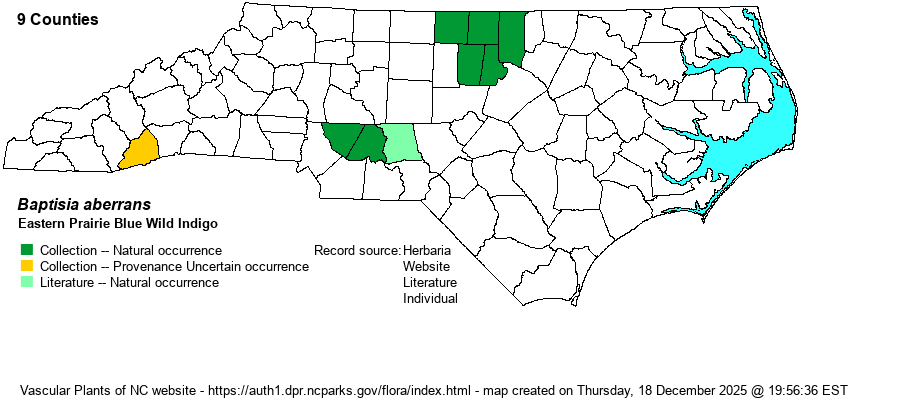| Author | (Larisey) Weakley | |
| Distribution | Primarily limited to a small area in the northeastern Piedmont -- Caswell, Person, Granville, Orange, and Durham counties. A few records for the southern Piedmont (Cabarrus, Stanly, and Montgomery counties). A specimen from Transylvania County in the Mountains may refer to an introduced population.
This species has a primarily East-central range (especially in KY and TN), and occurs sparingly in the eastern states. Ranges northeast to PA and south to NC and GA (but absent from SC?). | |
| Abundance | Rare and somewhat local in the northeastern Piedmont, mainly from Butner in Granville County southwest to Durham in that county. Very rare elsewhere from Granville to Caswell counties, though of historical occurrence in Person and Orange counties. Extremely rare southward, and also apparently gone from Cabarrus County. As it has declined considerably over the past few decades, it is listed as State Endangered. NatureServe now lists this taxon as a full species as of 2022, with a Global Rank of G2. | |
| Habitat | This is one of a handful of "prairie plants" in NC -- species whose main range lies in high pH prairie-like or glade-like habitats west of the Appalachians. In NC, this is a species of mafic glades, barrens, and wooded margins, even at times in overgrown pastures, but always in sunny and rather dry sites, over diabase or gabbro rocks. At most sites where it still occurs, there are one to many other rare plant species present. |
| Phenology | Blooms from late April into early June, and fruits from June into August. | |
| Identification | This is one of the state's most beautiful wildflowers, often planted in yards and gardens. It is a moderately bushy-looking herb that grows to about 2 feet high, with quite waxy smooth but glaucous blue-green leaves. The alternate leaves are trifoliate, with each of the 3 leaflets being obovate in shape and about 2 inches long and half as wide (fairly large leaflets for a legume). The ball-like growth form is often sufficient for identification, but when the deep violet-blue flowers are in bloom, there is no mistaking it. Each of the several racemes are terminal on branches and extend outward beyond the leaves, and each raceme is often 4 inches long or more. Also, the flowers are large, each nearly 1 inch long. After blooming, the plant has strikingly large dark pods that are each about 2 inches long and 1 inch wide. As this species is so conspicuous where it occurs, you are not likely to discover a previously unknown population. Thankfully, a few populations can be found on public lands in the Durham and Butner areas. | |
| Taxonomic Comments | This taxon has undergone so many name changes that it can be confusing to follow them! The RAB (1968) manual named it as Baptisia australis, and many references still do, often with a variety named for the NC population. Also, it has at times been included in B. minor, such as B. minor var. aberrans. Weakley (2018) has the aberrans taxon (a more easterly taxon) split off as a valid species, which this website follows.
| |
| Other Common Name(s) | Prairie Blue Wild Indigo, Glade Wild Indigo, Blue False Indigo. Both this species and B. australis are called Blue Wild Indigo, and thus the editors want to use modifier names for both. Weakley (2024) also uses this as his first common name. | |
| State Rank | S2 | |
| Global Rank | G2 | |
| State Status | E | |
| US Status | | |
| USACE-agcp | | |
| USACE-emp | | |

